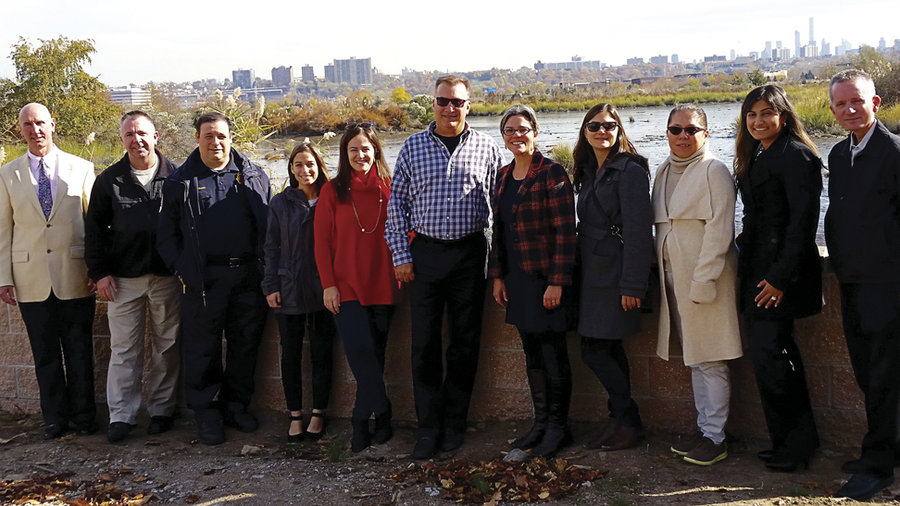“The spirit of self reliance in Secaucus is one we’ve really been impressed by,” said Holly Leicht, regional administrator for New York and New Jersey. “The combination of thinking out of the box, being scrappy and creative and resourceful.”
Leicht was one of five representatives from the Department of Housing and Development (HUD) who toured Secaucus’s flood control projects for the second time on Monday, Nov. 9. They had come to view the progress over the past year, and had nothing but praise for the various projects underway or completed.
“Secaucus continues to impress – you continue to be a model of creativity and initiative,” she wrote in an email after the visit.
While Secaucus was excluded from one large-scale anti-flooding project in the region, Leicht looked at various smaller projects around town to combat future flooding.
After Sandy, what’s changed?
Superstorm Sandy inundated Secaucus and much of the region in the fall of 2012. In the wake of the devastation, the federal government established the Rebuild by Design competition to engineer large-scale projects to address flooding and weather issues. HUD pledged more than $900 million to various projects intended to increase resilience across the region. That was in June 2014.
Yet only a couple of months ago, Hurricane Joaquin threatened the East Coast with a potential rainfall threat greater than Sandy, and some towns were still unprepared.
“What Secaucus is doing is really a great model for vulnerable towns all along the coast, in New Jersey or other states.” –Holly Leicht
____________
The answer, she said, is “taking incremental steps along the way.”
And that’s where Secaucus has been a leader.
Moving forward without fed funding
Leicht oversees a team of individuals hired by HUD and paid for through FEMA specifically for Sandy recover. She started at HUD in January of 2014 to help transition the Rebuild by Design competition from the idea stage to the implementation phase.
Ten projects were proposed through the competition, with six eventually chosen. Secaucus officials were initially frustrated, as the town was excluded from a project called the New Meadowlands project that was conceived to increase resiliency throughout the wetlands region.
“Secaucus is not in the first phase that got funded,” Leicht said, “but we have talked to the state about the fact that it’s really important that whatever does get implemented [is part of] a broader plan for the whole Meadowlands area.”
But Secaucus got to work immediately after Sandy, installing flood walls, raising berms, building pump stations, and much more.
“What Secaucus is doing is really a great model for vulnerable towns all along the coast, in New Jersey or other states,” said Leicht. “Looking for creative ways to accomplish things for the short term as well as a more complex longer term vision.”
Localized solutions
The HUD team first visited Secaucus a little over a year ago and came back at the invitation of Mayor Michael Gonnelli. The five HUD representatives traveled by bus with town officials on a tour of about an hour and half, visiting flood barriers constructed with materials salvaged cheaply in creative ways, along with pump stations, generators, and parkland.
“The way they approached this is exactly right,” said Leicht. “Looking at every single block, every single lot to see what has to be done in a site-by-site analysis. Recognizing that it’s a complicated environment, it’s not one thing, utilizing sea walls, berms, dams, and strategic land acquisition.”
In some towns, she explained, the resilience projects must be large-scale and comprehensive, like along the Jersey shore. “That can’t be a town-by-town project. It has to be an integrated approach with an interjurisdictional imprimatur.”
Secaucus, on the other hand, can apply localized solutions. “We see this as a layering effect and Secaucus is very good at the first layer,” she said. “It’s exciting for us. My team is working on a lot of really long term infrastructure projects.
She added, “The momentum will be there to continue seeking out funds for the other towns to be folded into the [New Meadowlands] project in the future. I am confident that Mayor Gonnelli and Secaucus will hold the state’s feet to the fire to make sure that that larger piece is not forgotten.”
Art Schwartz may be reached at arts@hudsonreporter.com.
